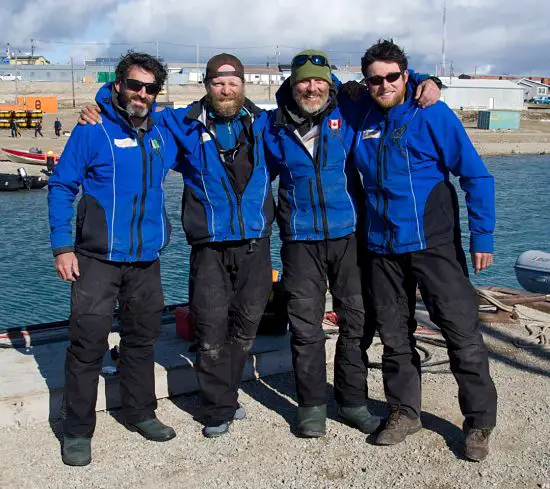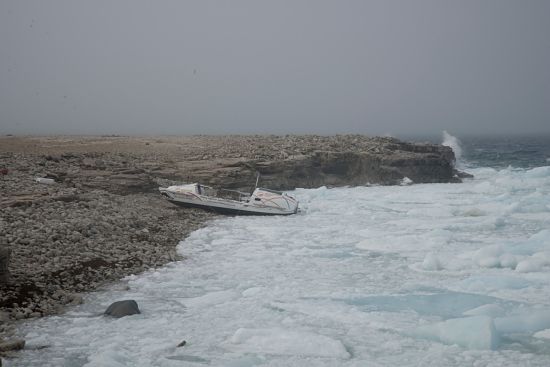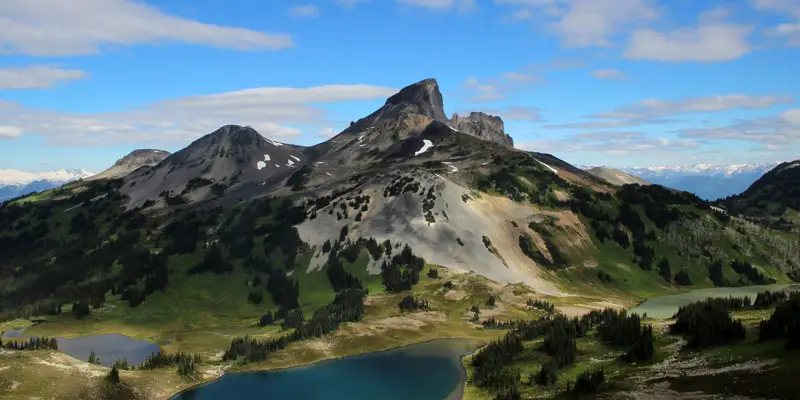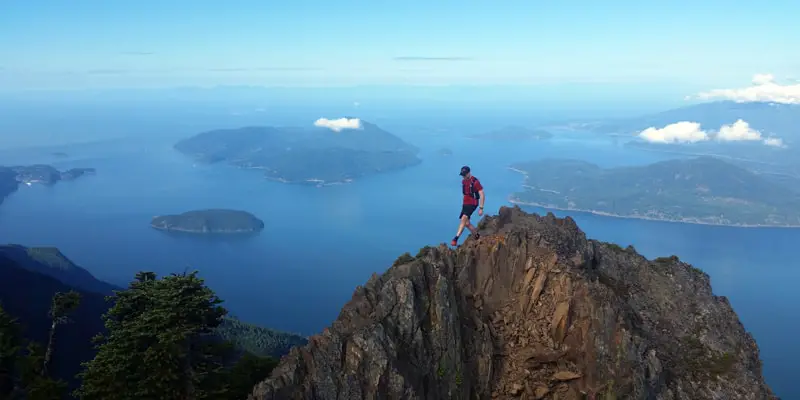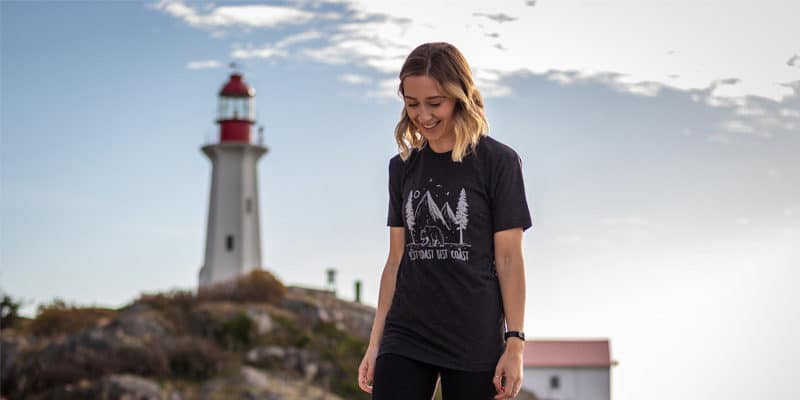Tales from the Outdoors is an ongoing interview series featuring some of the most inspiring and motivational local athletes. Covering a myriad of outdoor pursuits across all skill levels, these are the stories of Vancouver’s finest adventurers. To see previous interviews in the series, click here.
Kevin Vallely
On July 5, 2013 North Vancouver resident Kevin Vallely, along with three teammates, set off on the Mainstream Last First Expedition in a bid to become the first ever to self-propel (no motor, no sail) themselves across the Northwest Passage in a single season. The team was tasked with rowing themselves in a 25 foot custom-made boat, 3,000 kms through icy cold waters. The goal of the expedition was to illustrate the dramatic effect climate change is having on the world, and in particular, the Arctic.
Unfortunately for the crew, this summer season was a particularly harsh one in the Arctic, with a lot of ice and unusual wind patterns. But Kevin is no stranger to cold weather or a challenge. Kevin has been blazing new paths all over the world for decades and his athletic resume is impressive to say the least. Kevin is known for:
- Breaking the world record for the fastest unsupported trek from Hercules Inlet to the South Pole with teammates Ray Zahab and Richard Weber (2009)
- Retracing a 2,000 kilometer Klondike-era ice-bike route through the dead of an Alaskan winter (1999)
- Completing Vancouver Island’s West Coast Trail in record time of 10 hours, 13 minutes (1997 – a record since broken by a few minutes)
- Skiing Alaska’s 1,860 kilometer Iditarod Trail (2000)
- Attempting to bike and climb the island of Java’s 13 -10,000-foot volcanoes (a trip cut short when post-9/11 Indonesia became too dangerous) (2001)
And this is just a sampling. For a full list of Kevin’s impressive expeditions, click here. Kevin was also named one of Canada’s leading adventurers by the Globe and Mail in 2003.
I remember watching Kevin speak at the 2009 VIMFF about his South Pole expedition and being blown away by the conditions the team pushed through to break the speed record for that trek. Moving day after day, on almost no sleep and eating frozen sticks of butter in an attempt to help lessen each day’s caloric deficit, it’s an incredible story. In 2011, Kevin spoke about the South Pole Expedition at FEAT Canada, and you can view the 10 minute video below:
For the Mainstream Last First Expedition, the crew set out on July 5, 2013 and the journey came to a conclusion on August 28. The team fell short of the ultimate goal of making landfall in Pond Inlet, however the trip was still an eye-opening one. Along the way, the crew saw animals, that even a decade ago, were unheard of in the Arctic. They spoke with locals and heard stories of just how drastically the climate has changed in the last few decades.
I recently sat down with Kevin and was able to hear more about the expedition, and the challenges the crew faced.
Interview
KW: How did the Mainstream Last First expedition come to be?
KV: The Northwest Passage, for me, was something that was on the books for the better part of 15 years. The original idea came with a good friend of mine Jerome Truran. Jerome used to work at the Co-op and was one of these real sandbaggers – you don’t know anything about the guy until you start to dig a little more. I was reading a book called Running the Amazon about the first team ever descend the Amazon River from source. We were chatting about it and he says ‘yeah, I was a part of that team‘, and I remember I was at the Co-op looking at the book like ‘you gotta be kidding me‘! And he says ‘that’s me on the cover, paddling the Acombamba Abyss‘. This is the sort of guy he was. He was one of the best paddlers in the world, in the day. So we really hit it off really well and he became a guy I really looked up to. We were chatting about expeditions that had never been done – world firsts, the things left undone. And hence, in some ways, the name of this expeditions was the ‘Last First’ as in the last, first left to do. We were toying with the idea 15 years ago of trying to traverse the Northwest Passage solely under human power in a single season. At the time it was impossible because of ice. Truly impossible. But we both joked ‘just wait a decade or so and you’ll be able to do it‘.
Well, decade-and-a-half later, last year, it was very doable. It was wide open. The idea had already been there, we were already planning this, but last year sort of proved it to us that we were onto a good thing. And last year myself and teammate Paul Gleason were speaking at a festival called FEAT, and he was intrigued of the idea of going to the South Pole, and I was intrigued by the idea of ocean rowing. Paul had rowed across the Atlantic Ocean. And I thought ‘wow, that might be an interesting way to get across this passage‘ because at the time, in my mind, kayaking was not the solution because some of the crossings are massive. And I suppose there are paddlers out there that could do them that wouldn’t be me. So I thought an ocean rowing craft might be the way to go. So, long story short, we met over coffee and I pitched the idea to him and he was all in. A week later he called me and said ‘I’ve thought of nothing else for the last week‘. So, we each chose a teammate and I chose Frank Wolf. Frank is without doubt one of the best adventurers in Canada, if not the world, and an incredibly accomplished documentary film maker and is probably my best friend so it was an easy selection. Paul selected a friend, Denis Barnett, who had never done anything like this before and so it was an interesting thing having the real rookie coming on board. And our team was made. And from that point forward it was probably a year and a half of effort to get it going. And that’s what people don’t realize. The expedition takes 2 months, but the prep for an expedition can take years in terms of sponsorship and everything else. And this was a biggie, I mean we had to build a boat.
KW: Once you were underway, how did the journey go and what were some of the surprises that came up along the way?
KV: [Laughs] Yeah, lots of surprises. The reality was, sadly, this year was the coldest year in about 15 years. And I’ll talk about how that doesn’t mean anything in terms climate change. The reality is it was a really bad weather year. It doesn’t mean anything about the climate, which happens over decades – and even with a really bad weather year we’re still seeing less ice, so I mean that’s another story in itself. But surprises we had along the way; we were told the weather conditions and wind conditions would be fairly consistent, to some degree. Northwesterlies and westerlies would push us along – where the currents go and it would work well for us. Well for the first three weeks we had northeastertlies and easterlies and northerlies. We were just getting pummeled by winds that was erratic, that were not normal. We were told by the mayor of Inuvik, the ex-premier of Northwest Territories, Floyd Roland – we met with him for an hour before we left – and he was describing to us the changes he saw since childhood and described how you’d expect when he was growing up, when they would hunt, four or five days of fairly consistent weather. It went in cycles like that. And he said nowadays you would expect cycles of four of five hours. And sure enough that is exactly what we experienced. We had these profound changes and erratic weather. And that is something that surprised us a lot. Frankly, that really put a damper on everything. We were supposed to be rowing. We were hauling our boat along the beaches. We were supposed to be doing big crossings of bays, but we couldn’t! There were massive flows of ice that would have just crushed us, literally! If we got caught in this pack ice we would have done for. So that’s something we didn’t expect – that much ice. Way more ice this year, and the winds were blowing in such a way that they were clogging up the passage, pushing it down into the archipelago. It hadn’t been like that in the last number of years, so in some ways we had a rough go of it [laughs].
It was a fairly sea-worthy vessel but, a guy from the department of fisheries and oceans who we were dealing with was up there this summer in the Amundsen Gulf and he sent me an email at the end of the trip congratulating us. He said ‘I spent this summer the Amundsen Gulf in a 40 meter fishing boat, and you guys were in a 25 foot row boat, and I s*** myself out there. I don’t know how you guys dealt with that‘. And that’s exactly what it was. It was pretty full-on in a lot of ways.
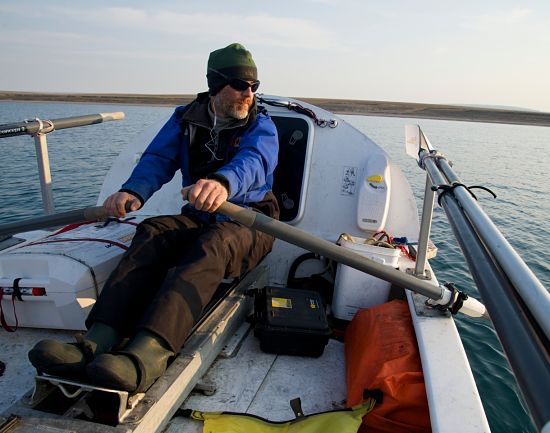
KW: You talked to a lot of locals from northern Canada along the journey. In terms of the overall trend in the climate, what did they say, and what are some you noticed along the way?
KV: Lots. Fellow Billy Jacobson, he was an elder in Tuktoyaktuk, explained to us how grizzly bears were being seen now on Banks Island which is way north near the M’Clure Strait. Unheard of. Wolverines as well.
We saw firsthand how the graveyard in Tuktoyaktuk is melting and falling to the ocean because the permafrost is melting.
We saw beavers, we saw a beaver, on the Arctic Ocean! And we laughed a first and we said ‘That can’t be a beaver. There are no beavers on the Arctic Ocean. It must be an otter or something‘. But there are now, and they’re damming up the rivers. They’re affecting the runs of white fish.
Hank Wolki in Paulatuk told us about how they’re now picking blueberries at the end of September which is unheard of. The ice was already freezing at that point when he was a kid. And now it’s a month later that the ice is coming in and they’re too scared to even travel on it without an elder to see and know where to go. And to see killer whales there now.
Steve and Joe Ilisiak told us about the new bear on the scene – the grolar or pizzly bear – which a combo bear between a grizzly and polar bear that mate. They’re a bad-ass bear, and they’re this mutant bear. And the interesting this polar bears came from being a brown bear 350,000 years ago and so they share the same genetics and they can breed. And evidently they’re not fertile, they can actually breed again. A grizzly bear is a terrestrial animal. it’s territorial, hence its defensive stance to peoples and other animals. A polar bear lives on the ice, it doesn’t have a territory, it freely roams. So what does a pizzly or grolar do? It’s kind of this hybrid that maybe isn’t good at anything. But what they are is dangerous, we heard, and big, and nasty. It’s just another thing.
And we spoke to an elder named Jimmy in Cambridge Bay about when the sea ice leaves the bay. And we asked him ‘When you were a kid, when did the ice leave the bay‘? And he just laughed, and said ‘Kevin, when I was a kid, the ice didn’t leave‘.
And I could go with stories, and on and on and on. It’s changing profoundly up there. Our anomaly this year, even so, this year, coldest year in 15 years, it’s still going to be the 6th lowest ice-extent ever recorded.
KW: What were the conditions like on boat, drinking desalinized water, and so on?
KV: That’s where the experience came in. We were in really tight quarters. We were stuck in the same clothes for 60 days, so it was… interesting. But we got along, amazingly. We played a lot of cards, hearts, when we were stuck in the cabin for days at a time. We just knew to deal with it. Most of the time we were trying to row all the time – two guys on, two guys off – and then there’s tons of room. [Laughs] Well, not really, but there’s room. Four guys, if you’re lying out, you are pressed up against both guys on both sides. But you get used to it and we knew that going in, and you just have to deal with it. And we got along really well and there were no fights.
KW: Looking back at the expeditions you’ve done, do you have a favorite?
KV: A lot of favorite memories. Every expedition you do is kind of your favorite in its own unique way.
The South Pole was epic and amazing because I had always dreamed of going there and not only did we get there but we broke the world record. It was an amazing feeling of accomplishment. Even though there’s a let-down in doing something like that when you realize it’s all the journey of getting there that really matters, because the South Pole is a patch of snow like anywhere else. So in some ways you have to look back to your first. I skied the Iditarod Trail with Dave Norona and Andy Sterns. And in some ways that might be the most amazing one, just simply because I never thought I could do it. I didn’t know what I was doing and I did it. And it was just like, you come away, changed. You come away changed less a little bit each time you do them because you kind of know what you’re doing. But when you don’t know what you’re doing, it’s totally new.
KW: When you’re not travelling the world, what are your favorite things to do locally?
KV: Trail running. I’m a big-time trial runner. And in some crazy way, it was Frank and I, my teammate, running the West Coast Trail – we did it eons ago in 1997, and at the time we had the record – Gary Robbins beat it recently by 5 minutes – but we had the record for a long time – which we didn’t really care about at the time because we just kind of winged it, but we had a fast time I guess. But it was that sensation of moving fast, and doing something a little bit audacious, in a way at the time. It’s almost more understandable now. Back then it was like ‘you’re doing what!?’
In a way, the trail running, which is local thing, I’ve always been doing it and I love it. It gets me out into nature. I did that today. That’s what I do, that’s my escape. I just fire out at lunch and I’ll be in the mountains and I nearly ran over a deer today, literally. I could have grabbed it by the head, it was right there. It’s always amazing. I can step in the forest because I live here in Lynn Valley. I mountain bike, and I paddle and I ski, and I do a bit of everything but my fallback sport seems to be trail running.
———
Frank Wolf is working on the documentary about the expedition, which is planned for release by the end of summer 2014 . This November 26th, at Centennial Theatre in North Vancouver, Kevin and his teammates will be presenting a slideshow about the trip.
I also encourage you to go back to the blog on the expedition website to learn about the build up to the journey, more details about the trip itself.
Here is the video teaser for the Mainstream Last First Expedition:
